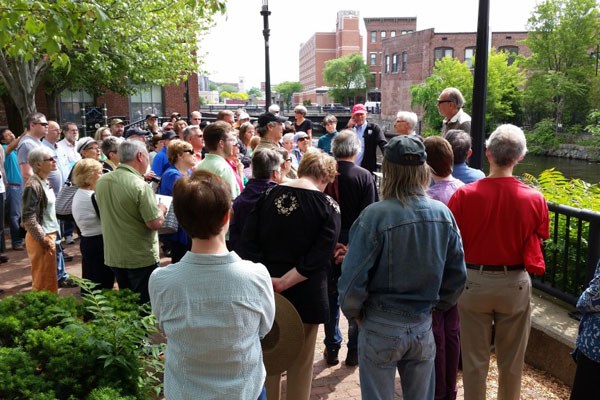University Co-sponsors 'Lowell Walks' Series

06/11/2015
By David Perry
Early on the Saturday morning tour, Fred Faust told a crowd of 81 a story about the mix of federal and local funding for sculptor Mico Kaufman’s Homage to Women statue in the courtyard along Market Street in downtown Lowell. Decades ago, Lowell’s progressive workhorse U.S. Sen. Paul Tsongas secured $75,000 in federal funding for the bronze statue, which celebrates the labor of women in Lowell’s industrial revolution.
Tsongas assigned his then-aide Faust to get the other $25,000 from local sources. The door through which Faust had to pass was Joe Tully, the crusty city manager and political cog who turned or froze the faucet of power and money in the city.
It was a fascinating insider’s tale (in which the funding eventually appeared, via Tully, but not before he pronounced the sculptor’s design, “like a bunch of lobsters dancing”) and brought the city’s rich history to life.
Faust’s anecdote-packed tour of downtown kicked off the newly launched weekly Lowell Walks series, which is co-sponsored by the richardhowe.com blog, UMass Lowell and the Lowell National Historical Park. The walks feature a different tour every Saturday through Sept. 12, save for July 4 and July 25. Tours operate rain or shine.
The tour ran like clockwork, stepping off at 10 a.m. from the Lowell National Parks Visitor Center and wrapped up at 11:30 a.m., a couple blocks away. As Faust, now the president of a real estate consulting firm, recounted the stories behind several iconic downtown buildings, he was joined by a sort of Lowell history all-star team, including Chuck Parrot, architect for the Lowell National Historical Park, and Richard Howe, Jr., Register of Deeds for Middlesex North District, a local historian, blogger and founder of the walking tour series.
“The root of it was the success of the Lowell cemetery tours, which I’ve been doing for five years now, said Howe. “They’re free, with no reservations required, and we get plenty of people every time. So there is clearly a market here for what I call, ‘interesting stories.’ And there’s a bit of economic development marketing, too. I really think the more people go to downtown Lowell, the more people are won over and return.”
The idea, he said, “is simply to take people around to all the entertaining things and the stories that occur downtown. It’s not something I could do myself, so I recruited 13 other people who I thought would be great at this.”
The university, working to more deeply weave its students’ experience with the downtown, is “a great partner to have,” said Howe. “I think the future of Lowell is completely tied to UMass Lowell.”
The walking tour schedule includes a pair of UMass Lowell notables, Community and Cultural Affairs Executive Director Paul Marion (leading the June 13 “Lowell Public Art Collection” tour with his wife, Rosemary Noon, assistant director of the Lowell Plan) and history Prof. Bob Forrant, who covers “The Abolitionists” on Aug. 1.
The series’ June 6 maiden voyage was loaded with nuggets. There was the mighty Bon Marche building, St. Anne’s Episcopal Church, a canal stop, cupolas, Greek Revivals, and the time Tsongas called up a bank president whose modernization was “incredibly ugly,” according to Faust. The bank had promised to clean up its act but had done nothing. “If you don’t take that down,” Tsongas finally barked, “I’ll be standing outside announcing you’re going to do it anyway.”
And more gems: Abraham Lincoln spoke at the old City Hall (located on Merrimack Street, now the Enterprise Bank building) in 1848 and was one of six who became U.S. president to visit there. The food and goods market area along Market Street once hummed like Faneuil Hall. The floors of the former Patrick Pierce gallery along Market Street slope toward the middle so blood could drain in the former slaughterhouse.
Faust recounted how several times preservationists have fended off revitalizations that would drastically altered the downtown’s architectural flavor.
When stucco and sliding doors were installed in the 1889 firehouse on Palmer Street (now housing Fuse Bistro) preservationists were told, “it’s California style and it’s coming to Lowell,” Faust said. Alas, the sunny trend was ejected like a rowdy bar patron.
And one more interesting note.
The red-brick firehouse was built in 1889 because the firehouse before it burned down.
About a dozen folks raised their hands when queried how many did not live in Lowell.
Szifra Birke was not among them. She was born in Lowell and her parents, Nathan and Sally Birke, owned Birke’s, a well-known department store that opened in 1947 and moved to its best-known location, Market Street, in 1960, eventually closing in 2004.
“Being a tourist in my own town was delightful and captivating,” said Birke. “I understood in a new way why movie makers and tourists come to Lowell for the beauty and grandeur of our old and diverse architecture.”
She loved the story behind Kaufman’s sculpture, and “really saw the beauty of the Bon Marche building’s architecture for the very first time.”
